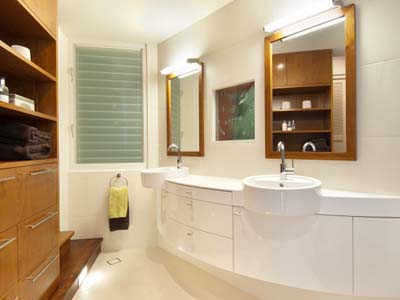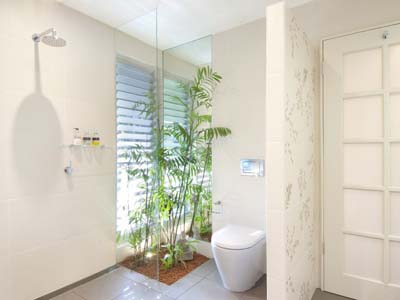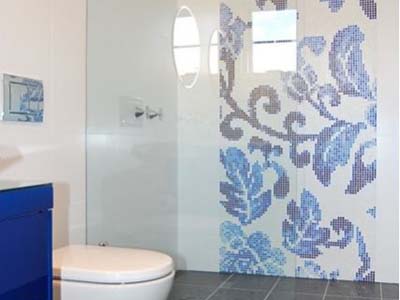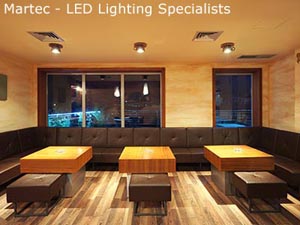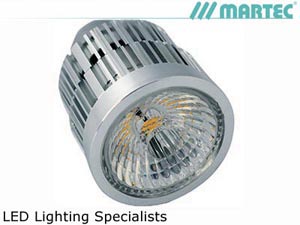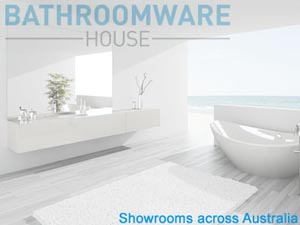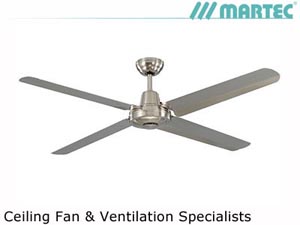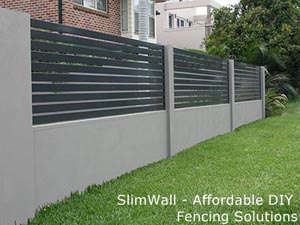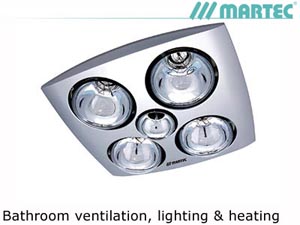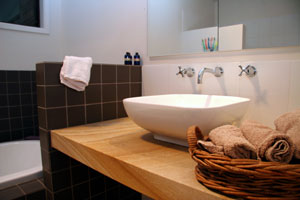

The Australian bathroom has come a long way from the floral tiles and deco style that spruced up the utilitarian bathrooms of the fifties. Now, with features such as open double showers, beautiful composite finishes, space age toilets and exotic (even alloy) tiles, bathrooms can, for not too much money, appear luxuriant and stylish.
Designing your bathroom
Does the bathroom need a re-design or not?
What to do with a bathroom really depends on how the bathroom is used. An entire family using one bathroom warrants more upgrading, features like double showers and basins, will be required for a family bathroom to function well.
Redesign or refinish?
The first question to ask is whether the bathroom needs a whole new re-design or just a new fitout. For example moving showers, doors and toilets can make a bathroom function better and look more spacious, however changing the configuration costs extra, as it will mean altering; plumbing, wall construction and electricals. If the room doesn't benefit from a reconfiguration don't do it. A new fitout will be expensive enough.
Designing
Like any space in the home the bathroom needs to be designed properly. This is the process you should follow:
- Research - Follow our DIY home design article as a guide on design considerations. Study the current and proposed configuration of your bathroom. You need to analyse the existing bathroom and its unchangeable features, and understand how these will impact on your ideas.
- Drawing tools - You can hand draw your bathroom plan to scale or buy a simple computer program or App for creating house plans and play with different layouts. Alternatively, download our cutouts file (1:100 scale) and place them on your hand drawn plan (that is also 1:100 scale) and play with your bathroom layout options.
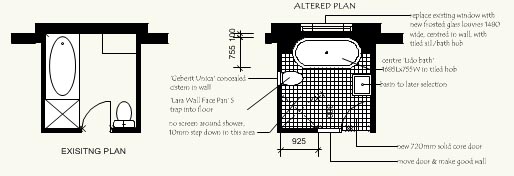
- See our our article on drawing plans that explains scale more. Once the plan is done, draw up the elevations as well (also to scale) with wall dimensions and positions of existing windows and doors etc. See professional Wet Area Drawing above as an example.
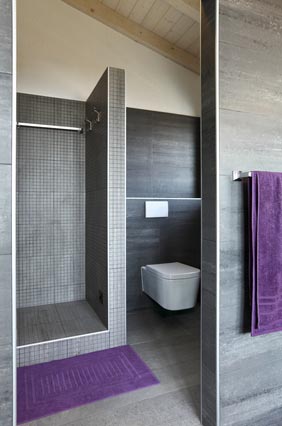
Colour of the year 2014 - Radiant Orchid
Design ideas
Ventilation
Building codes do not require bathrooms to have a window, but natural ventilation is best. If you have to rely on a mechanical ventilator make sure it ducts to the outside of the house rather than going into a ceiling cavity. Don't forget to have a power point installed for the exhaust (it should be preferably located in the ceiling).
Storage
Placing your windows nearer to the ceiling. This will free up lower wall space for your storage needs.
Windows and doors are nice
- A Design feature - A big operable window or even a door onto a garden is always a nice touch.
- Swinging doors - Make sure your shower screens and bathroom doors comply with minimum door clearances for bathrooms. If the door into bathroom opens inwards it must be no closer than 1400mm from the edge of the toilet seat. If the door is closer than this it will need to be specially hinged to allow it's vertical removal (so that if someone collapses behind the door it can be removed). Occationally you will see bathroom doors opening outwards (not a good look, but it will ensure compliance).
- Sliding doors - Sliding doors, especially when hidden in an in-wall cavity take up less space than a hinged door. However a hinge-solid core door is more sound proof than a sliding-core-filled door. If you are using a hinged door hang towel rails on the back to save space.
Colour
Choosing colours for walls, floors and cabinetry can be tricky. Light colours (neutrals or whites) will make a room feel larger. For more information on picking colours see our Picking Colours guide.
Only ever use three colours in any room. If the room is small use two. Also think about how your colours will work with those in adjacent rooms, because at door thresholds both rooms will be seen at once.
See our design tips page for more tips on colour.
Bathroom cabinetry
- Floating cubboards: When the entire floor is visible there is a great feeling of space. Cabinetry is best floated in a small space - raised off the floor with thin steel legs or screwed firmly to the wall.
- Reducing angles: While storage is essential in a bathroom, cabinetry is best hidden into the walls to create a clean look and of space. As much as possible make cabinetry recessed into walls and flush with walls. The vanity mirror offers a perfect place to conceal a narrow cupboard. Keep the cabinetry simple with clean edges and avoid using too much timber which will make the bathroom look heavy.
- Simplicity: Unless you want a rustic or a french provinchial bathroom avoid painted timber especially with busy decorative and relief design. While cabinetry should be as discrete as possible, it is also very practical to have some simple exposed shelving near basins, bath, and shower.
Tiling & walls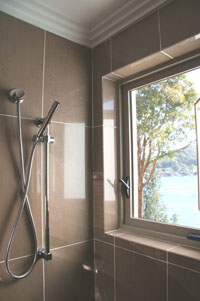
Tiled window hob pictured.
- Tile size: Larger tiles create a greater sense of space than small tiles. This is an important consideration in small bathrooms. However larger tiles are harder for tilers to install due to their wait and more precise cutting and laying requires to accommodate angles and drainage holes. If you use two different sized tiles makes sure that the smaller ones are half the size of the larger, so the grout lines can match up. Rectified porcelain tiles are identically-shaped and allow narrower and less obvious grout lines to be used. This also helps create a sense of space.
- Tile format - Wall tiles that extend to the ceiling can make a small bathroom feel larger by drawing the eye upwards. Tiled should be layed in a square format where possible, not on the diagonal. Diagonally laying tiles forces tiles to be cut. A bathroom will look neater where tiles cuts are kept to a mimimum.
- Grouting lines: Ensure grout lines on the floor match-up with grout lines on the walls. Use a grout that matches your tile colours. You may need two different colours. Standard grout joins are 3mm wide. This is to allow for expansion and constraction of tiled floors. If tiles are butted against eachother there is a chance that they will buckle upwards.
- Tile design: Tile designs go out of fashion 'very' quickly. If you want your bathroom to appear classic and dateless use plain white/cream tiles on all surfaces. Avoid heavily patterned tiles at all costs.
PC items
Selecting bathroom items can be daunting especially if you have a few bathrooms to fit-out. If you have no idea on how to go about this process, see our Picking Better Bathroom Fittings article and play with our Bathroom cost calculator here.
Showers
The shower is both a place to wash and a place to relax and pamper yourself. You might consider showers with multiple heads to create a spa like wash, horizontal arms, extension hoses and double showers for couples.
Frameless shower screens and clear glass create a greater feeling of space. Avoid shower with designs on them - they date the room and reduce the feeling of space. Try to include a step-down into the shower of about 10mm to control water.
Semi-frameless shower screens are a more economical option to frameless screens.
Basins
While many wash basins are internally rounded, if their outside shape is geometrically square they will look better in square edged cabinetry.
Freestanding or pedestal wash basin are great for bathrooms with little space but they offer no possibility for cabinet storage (try a bank mirror cabinets to compensate).
Baths
Acrylic bathtubs are cheaper and warmer to the touch compared to cast-steel tubs that can chip easily revealing dark cast steel underneath. Acrylic can be repaired with with "wet & dry" sandpaper - unlike steel that will need professional renovation. If you want a bath tub and space is limited, find one that is small but deep and center a modern ceiling mounted shower over head.
Your bathroom will age better if you pick classic PC items such as a plain white free standing bath and pedestal basin.
Floor structure
The type of floor structure can vary depending on bathroom plan, PC items and their locations.
If you have a tiled bath surround (tiled hob) the hob will need to be supported by a masonry structure. If a brick hob structure is used the weight of materials will warrant a concrete slab floor structure but if a hebel hob is used it can be supported by a timber framed floor - the lighter the hob structure the less solid the floor structure underneath will need to be to support it. Concrete slabs offer no better waterproofing base than timber floor structures - it usually comes down to material preference and budget.
Toilets
Toilets can be :
- Wall mounted
- Floor mounted
- or built in
The last option above is perfect for small bathrooms but don't forget about access for repairs. Make sure the builder or contractors knows the configuration of your toilet early in the renovation process (wall mounted toilets may require wall reinforcement).
Taps
There is a huge array of taps and bathroom accessories available. Styles vary according to taste, budget and function. The all-in-one, single tap mixer appeals to many for its easy use and streamlined appearance. Similarly there is a huge array of shower heads, many with adjustable nozzles and with sliding rails or extension hoses.
Make sure that the placement of a tap over your basin is not directly over the sink waste, otherwise the water will never swirl around the basin and it will drive you nuts. If the base of the basin is flat, ensure that it slopes a little towards the drain hole so that water will readily drain out.
The Australian Government has implemented important new water-efficient plumbing guidelines. In NSW see www.basix.com.au.
Designing a bathroom can be a highly satisfying and rewarding experience. While there may be one best way for practical matters (like the layout of a bathroom), there is often no best way to resolve aesthetic choices, like the best shape for a tap, or the best colour for walls. More than one shape or selection of colours might work. Aesthetic decisions are subjective but part of designing your bathroom, or your home the decisions you make are a reflection of you and your taste.
TIPS
- If your bathroom needs to incorporate laundry facilities, it may require additional power and plumbing outlets.
- Consider a skylight if the bathroom is dark or positioned away from northern or eastern sun.


